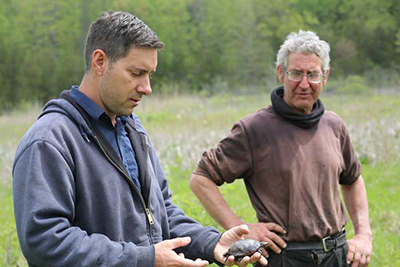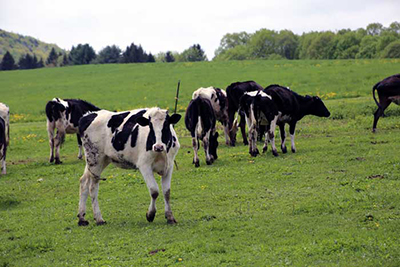
Pete Jones looked down at the muddy puddle.
“That’s my first bog turtle,” the dairy farmer said, watching as North America’s smallest turtle disappeared into a cow’s hoof print.
He looked over at the biologists with a grin and a wink: this refuted his suspicion that the wetland restoration on his eastern New York dairy farm had benefited ghost turtles.
Stumbling across this turtle — no bigger than the palm of your hand — in any cow pasture is indeed rare. But it’s no apparition.
Around the time that bog turtles were federally protected in 1997, they were increasingly discovered in grazed, marshy meadows on farms across the species’ range. Researchers dug in, figuratively as well as literally. Their findings, gleaned from two decades of research: the 4-inch turtle loves our largest livestock. Why the attraction? When the peaceful chompers graze, stomp and poop in the spring-fed meadows, they transform pastures into rich nesting habitat for their tiny friends.
That affinity brought biologist Jason Tesauro to Jones’ farm in 2009. Jones, 58, was dealing with densely growing invasive plants. They squeezed his fields, stealing the grass before it made its way to the cows’ stomachs. Jones resorted to buying feed to keep his herd fed, but he knew that couldn’t last. “Pasture is cheaper to feed the cows,” Jones said.
A timely discovery changed all that. Tesauro, a contractor for USDA-Natural Resources Conservation Service (NRCS), visited Jones’ meadows. What he saw stopped the biologist in his tracks.
“There, in a small hummock on the lower part of his property, were the remnants of a hatched bog turtle nest. I was like, bam! Here we go!” said Tesauro. The nest qualified Jones for enrollment in the NRCS Wetlands Reserve Enhancement Program.
Through the program, and with the help of the U.S. Fish and Wildlife Service (Service), Jones would regain his pastures and become steward of a large, bona fide bog turtle population. An estimated 40 thrive on his lands. Oh, and by putting conservation easements on 60 acres of his property, he’d get some extra cash back in his pocket.

Jones has been in the dairy business since he was 11, when his dad ran both a hardware store and a dairy farm. He left for Cornell University to study botany but wound up back with the cows.
“I like the cows, and I take care of them,” he said, perhaps unnecessarily. “They say that dairy farming is a business, but it really is a way of life. You do it because you like to do it.”
Jones and his one employee watch over 140 cows, about half of which are milking age. They send the milk off in a tractor-trailer from Marcus Dairy. He still puts corn on about 100 acres, hays 200 acres, and has over 100 acres in pasture.
He’s one of the few small dairy operations left in Dutchess County, about two hours north of New York City. The decline isn’t unique to the Hudson Valley. According to the USDA, the number of dairies nationwide dropped from about 3.5 million in 1950 to 58,000 in 2012 — roughly an 84 percent decline. Research also shows that large farms account for an increasing share of milk production; small farms, with lower yields, carry twice the production costs of big operations.
The realities, for a small dairy producer like Jones, are clear: It costs more to make less milk than larger competitors.
He unabashedly admits that the financial perks of the easements made them attractive. They’ve helped him keep the farm going while putting his kids through school.
“The money was a big incentive,” he said. “The improvement of the land was so important, too … Not only do I get to feed on it, but I like looking at it.”
 Sign In
Sign In
 Sign In
Sign In
